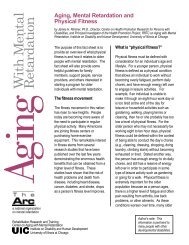Bridging the Aging and Developmental Disabilities Service ... - rrtcadd
Bridging the Aging and Developmental Disabilities Service ... - rrtcadd
Bridging the Aging and Developmental Disabilities Service ... - rrtcadd
You also want an ePaper? Increase the reach of your titles
YUMPU automatically turns print PDFs into web optimized ePapers that Google loves.
telecommunications systems that transfer calls between agencies to present <strong>the</strong> image of a<br />
seamless point of entry.<br />
The first round of ADRC grants was awarded to twelve states in 2003. The 2006 amendments to<br />
<strong>the</strong> Older Americans Act (P.L. 109-365) required <strong>the</strong> Assistant Secretary for <strong>Aging</strong> to establish<br />
ADRCs in all states (Title II Section 202 (b) (8)). By June 2011 <strong>the</strong>re were 365 ADRC program<br />
sites in 54 states <strong>and</strong> territories.<br />
The OAA authorizes <strong>the</strong> Assistant Secretary for <strong>Aging</strong> to take <strong>the</strong> lead in galvanizing federal<br />
efforts to develop <strong>and</strong> implement comprehensive <strong>and</strong> coordinated systems of long-term care at<br />
<strong>the</strong> federal, state, <strong>and</strong> local levels, <strong>and</strong> AoA is positioning ADRCs as a key component of <strong>the</strong><br />
long-term service <strong>and</strong> support system. AoA awarded grants to 28 states to access <strong>and</strong> coordinate<br />
Community Living Program (formerly <strong>the</strong> Nursing Home Diversion initiative) services <strong>and</strong><br />
supports through <strong>the</strong>ir ADRCs for people with limited financial resources who are not Medicaid<br />
eligible but who are at risk of nursing home placement. In 2008, eight states received CMS<br />
Person-Centered Hospital Discharge Planning Model grants to include ADRC options counseling<br />
<strong>and</strong> person-centered planning in hospital discharge planning for people with multiple chronic<br />
health problems to reduce <strong>the</strong> likelihood of re-hospitalization. ADRCs were involved in Money<br />
Follows <strong>the</strong> Person programs in 37 of <strong>the</strong> 44 states that received grant awards in 2007 <strong>and</strong><br />
2011. 31<br />
Challenges of ADRCs in <strong>Bridging</strong> <strong>Aging</strong> <strong>and</strong> <strong>Disabilities</strong><br />
Given <strong>the</strong> well-established community identity of <strong>the</strong> aging <strong>and</strong> disability lead <strong>and</strong> partner<br />
agencies in <strong>the</strong>ir community, <strong>the</strong>re is confusion among<br />
“There is <strong>the</strong> concern<br />
that ADRC may seem<br />
like a good idea at <strong>the</strong><br />
30-thous<strong>and</strong> foot level,<br />
but cannot provide <strong>the</strong><br />
individualized<br />
responsiveness that<br />
people need on <strong>the</strong><br />
ground. Not funneled<br />
enough to be<br />
operational, not able to<br />
embrace all disability<br />
populations.” (UCEDD<br />
administrator)<br />
providers, families, <strong>and</strong> persons with disabilities regarding <strong>the</strong><br />
role <strong>and</strong> function of <strong>the</strong> ADRCs. When <strong>the</strong> ADRCs were first<br />
implemented under <strong>the</strong> previous administration <strong>the</strong> model was<br />
not conceptually well thought out. ADRCs were initially<br />
conceptualized as single points of entry for long term supports<br />
<strong>and</strong> services for people with disabilities who are aging <strong>and</strong><br />
people aging into disability. ADRCs were <strong>the</strong>n<br />
reconceptualized as <strong>the</strong> “No Wrong Door” approach because<br />
each population has unique needs <strong>and</strong> <strong>the</strong>ir service networks<br />
are based on different philosophies. Consequently, each ADRC<br />
partner agency is autonomous <strong>and</strong> operates mostly with<br />
“business as usual”; <strong>the</strong>ir service network has not integrated<br />
<strong>the</strong>se parallel service systems.<br />
<strong>Bridging</strong> <strong>the</strong> <strong>Aging</strong> <strong>and</strong> <strong>Developmental</strong> <strong>Disabilities</strong> <strong>Service</strong> Networks Page 32



